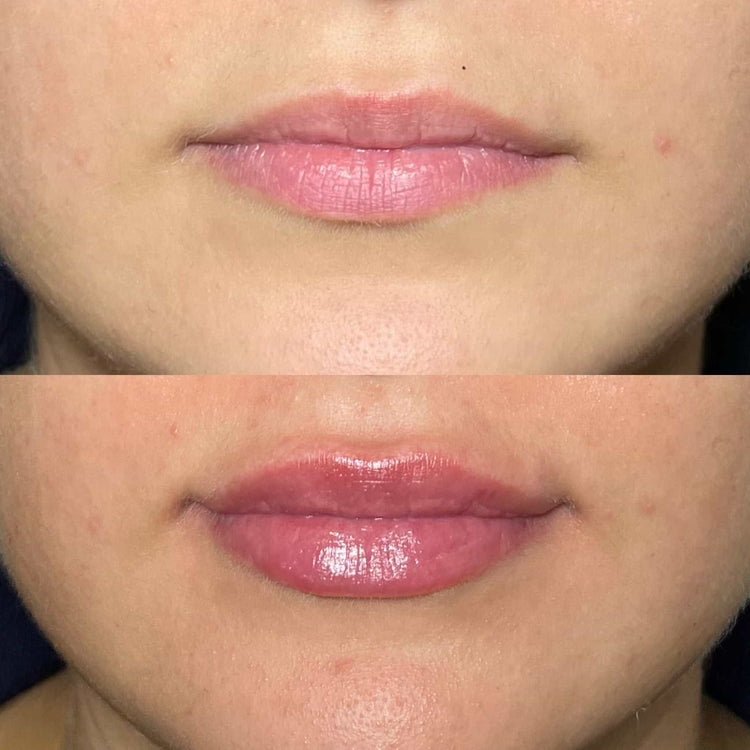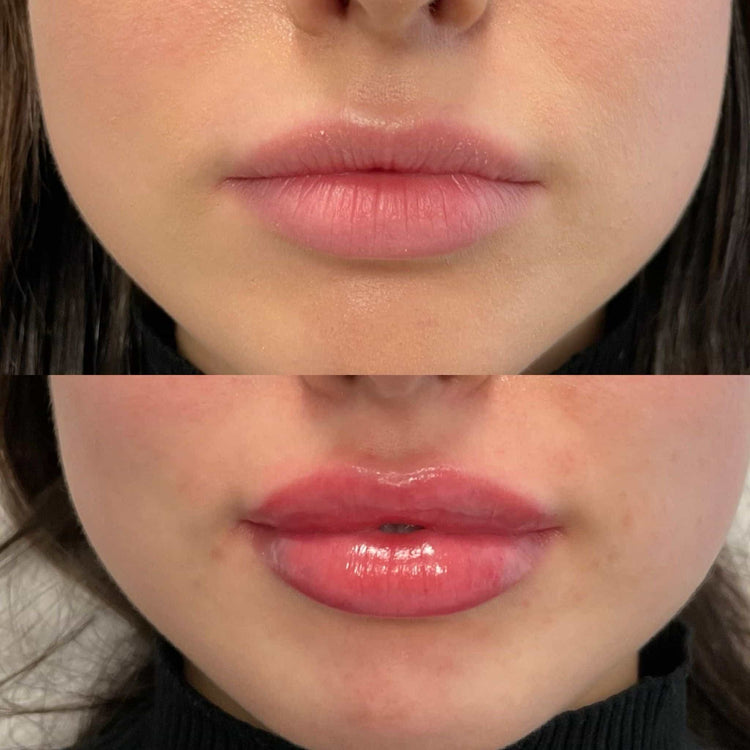Dermal Fillers
Dermal fillers have become increasingly popular as a non-surgical way to enhance facial features. One of the most common uses for dermal fillers is lip augmentation, allowing individuals to achieve fuller, more defined lips.
Types of Fillers Used
Lip fillers work by injecting a gel-like substance into the lips to increase their volume and shape. There are several types of fillers used, each with slightly different properties.
Hyaluronic acid (HA) is the most common type of filler used for lip augmentation. HA is a naturally occurring substance in the body that helps retain moisture and provides volume.
Other types of fillers include poly-L-lactic acid (PLLA), which stimulates collagen production, and calcium hydroxylapatite, which provides immediate volume and gradually degrades over time.
The choice of filler depends on the individual’s desired outcome, skin type, and any allergies they may have.
How Fillers Work
Lip fillers work by injecting a gel-like substance into the lips to increase their volume and shape. There are several types of fillers used, each with slightly different properties.
Hyaluronic acid (HA) is the most common type of filler used for lip augmentation. HA is a naturally occurring substance in the body that helps retain moisture and provides volume.
Other types of fillers include poly-L-lactic acid (PLLA), which stimulates collagen production, and calcium hydroxylapatite, which provides immediate volume and gradually degrades over time.
The choice of filler depends on the individual’s desired outcome, skin type, and any allergies they may have.
Enhancing Lip Shape
Lip augmentation has become increasingly popular as a way to enhance facial features and achieve fuller lips. Dermal fillers are injected into the lips to increase volume and modify shape.
Adding Volume
Lip augmentation has become increasingly popular as a way to enhance facial features and achieve fuller lips. Dermal fillers are injected into the lips to increase volume and modify shape.
There are several types of fillers used, each with slightly different properties. Hyaluronic acid (HA) is the most common type used for lip augmentation. HA is a naturally occurring substance in the body that helps retain moisture and provides volume.
Other types of fillers include poly-L-lactic acid (PLLA), which stimulates collagen production, and calcium hydroxylapatite, which provides immediate volume and gradually degrades over time. The choice of filler depends on the individual’s desired outcome, skin type, and any allergies they may have.
Defining the Cupid’s Bow
Lip fillers can dramatically enhance lip shape by adding volume to specific areas. One area often targeted is the Cupid’s bow, the dip in the center of the upper lip that resembles a heart.
By injecting filler strategically around the Cupid’s bow, practitioners can create a more pronounced and defined arch, giving the lips a fuller and more youthful appearance.
Fillers can also be used to balance the shape of the lips by adding volume to areas that are naturally thinner, such as the sides of the lower lip. This creates a more symmetrical and harmonious look.
Correcting Asymmetry
Lip augmentation has become increasingly popular as a way to enhance facial features and achieve fuller lips. Dermal fillers are injected into the lips to increase volume and modify shape.
There are several types of fillers used, each with slightly different properties. Hyaluronic acid (HA) is the most common type used for lip augmentation. HA is a naturally occurring substance in the body that helps retain moisture and provides volume.
Other types of fillers include poly-L-lactic acid (PLLA), which stimulates collagen production, and calcium hydroxylapatite, which provides immediate volume and gradually degrades over time. The choice of filler depends on the individual’s desired outcome, skin type, and any allergies they may have.
Lip fillers can dramatically enhance lip shape by adding volume to specific areas. One area often targeted is the Cupid’s bow, the dip in the center of the upper lip that resembles a heart.
By injecting filler strategically around the Cupid’s bow, practitioners can create a more pronounced and defined arch, giving the lips a fuller and more youthful appearance.
Fillers can also be used to balance the shape of the lips by adding volume to areas that are naturally thinner, such as the sides of the lower lip. This creates a more symmetrical and harmonious look.
Creating a Fuller Lip Line
Lip fillers can dramatically enhance lip shape by adding volume to specific areas. One area often targeted is the Cupid’s bow, the dip in the center of the upper lip that resembles a heart.
By injecting filler strategically around the Cupid’s bow, practitioners can create a more pronounced and defined arch, giving the lips a fuller and more youthful appearance.
Fillers can also be used to balance the shape of the lips by adding volume to areas that are naturally thinner, such as the sides of the lower lip. This creates a more symmetrical and harmonious look.
Considerations for Lip Filler Treatments
Lip augmentation has become increasingly popular as a way to enhance facial features and achieve fuller lips. Dermal fillers are injected into the lips to increase volume and modify shape.
Consultation with a Qualified Practitioner
Before undergoing any lip filler treatment, it is crucial to consult with a qualified practitioner. A thorough consultation will involve discussing your desired outcome, medical history, and any allergies you may have.
The practitioner will assess your facial structure, lip shape, and skin type to determine the best type of filler, amount needed, and injection technique for your individual needs.
It’s important to choose a practitioner who is experienced, board-certified, and uses safe and high-quality fillers.
Asking to see before-and-after photos of previous patients can also help you gauge the practitioner’s skill and experience.
Choosing the Right Type of Filler
Choosing the right type of filler is crucial for achieving natural-looking and long-lasting results.
Hyaluronic acid (HA) fillers are widely used for lip augmentation due to their ability to attract and retain moisture, providing a plump and hydrated appearance. HA fillers are also known for their smooth consistency, making them suitable for achieving subtle or dramatic enhancements.
Poly-L-lactic acid (PLLA) is another option that stimulates collagen production over time. While PLLA doesn’t provide immediate volume, it gradually enhances lip fullness and definition as the body produces more collagen. This type of filler is often a good choice for individuals seeking long-lasting results.
Calcium hydroxylapatite fillers offer immediate volume and can be used to sculpt specific areas of the lips. However, they tend to last for a shorter duration compared to HA or PLLA fillers.

Realistic Expectations
When considering lip filler treatments, realistic expectations are essential for achieving satisfying results. It’s important to understand that lip fillers can enhance fullness and shape but cannot drastically alter facial structure or create unnatural proportions.

During your consultation, discuss your desired outcome with your practitioner, bringing reference photos if helpful. They will assess your anatomy and recommend a treatment plan tailored to your individual needs.

Remember that initial swelling may occur after the procedure, so it’s crucial to allow for adequate time for your lips to settle and reveal the final result.
While lip fillers can provide noticeable enhancements, they are not a permanent solution. The effects gradually diminish over time, typically lasting anywhere from six months to two years depending on the type of filler used.
Potential Side Effects and Risks
Lip fillers offer a non-surgical way to enhance lip shape and volume, but it’s important to be aware of potential side effects and risks before undergoing treatment.
Common side effects include swelling, bruising, redness, tenderness, and itching around the injection site. These side effects are usually temporary and subside within a few days or weeks.
More serious, though less common, risks include infection, allergic reactions, and asymmetry. It is crucial to choose a qualified and experienced practitioner who uses sterile techniques and high-quality fillers to minimize these risks.
Individuals with certain medical conditions, such as bleeding disorders or autoimmune diseases, may be advised against lip filler treatments. It is essential to disclose your complete medical history during the consultation.
If you experience any unusual or concerning symptoms after treatment, promptly contact your practitioner for advice and follow-up care.
Get your dream lips today, book lip fillers with Dr. Laura Geige at It’s Me & You Clinic
- Why Can’t I Drink After Lip Filler - November 8, 2025
- What Is The Average Cost Of A Liquid Facelift? - November 6, 2025
- Sculptra For Skin Replenishing In Surrey - November 4, 2025
